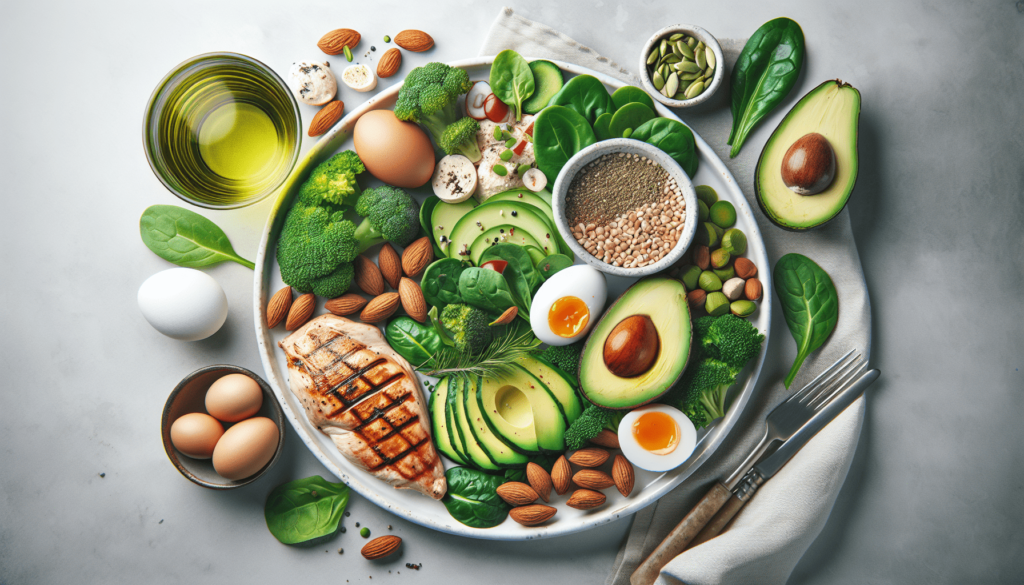Are you following a Keto meal plan and curious about incorporating intermittent fasting for extra health benefits? Look no further! In this article, we will explore how you can seamlessly integrate intermittent fasting into your Keto meal plan, allowing you to achieve your health and weight loss goals while enjoying a wide range of delicious and satisfying foods. With a few simple adjustments and mindful planning, you can harness the power of both Keto and intermittent fasting to optimize your well-being and enhance your overall results. So, let’s dive in and discover the secrets to successfully incorporating intermittent fasting into your Keto journey!

Understanding Intermittent Fasting
What is intermittent fasting?
Intermittent fasting is an eating pattern that cycles between periods of fasting and eating. It is not a diet in itself but rather an approach to when and how often you eat. This eating pattern has gained popularity for its potential health benefits and its ability to aid in weight loss.
Different types of intermittent fasting
There are several different types of intermittent fasting, each with its own unique approach. Some popular methods include:
-
16/8 method: This method involves fasting for 16 hours and restricting your eating window to 8 hours each day. For example, you may choose to eat only between 12 pm and 8 pm, and then fast for the remaining 16 hours.
-
5:2 method: With this method, you eat normally for five days of the week and restrict calorie intake to 500-600 calories for two non-consecutive days of the week.
-
Alternate-day fasting: This method involves fasting every other day, where you eat normally on one day and restrict calorie intake to around 500-600 calories on the fasting days.
Benefits of intermittent fasting
Intermittent fasting has been associated with several potential health benefits. Some of the benefits include:
- Weight loss: Intermittent fasting can help promote weight loss by reducing calorie intake and increasing fat burning.
- Improved insulin sensitivity: Fasting has shown to improve insulin sensitivity, which can help regulate blood sugar levels and reduce the risk of type 2 diabetes.
- Enhanced cellular repair: During fasting, cells undergo a process called autophagy, where they remove damaged molecules and repair themselves.
- Reduced inflammation: Studies have suggested that intermittent fasting may help reduce inflammation in the body, which is a risk factor for various chronic diseases.
Getting Started with Keto
What is a keto diet?
The ketogenic diet, often referred to as the keto diet, is a low-carb, high-fat diet that has gained popularity for its potential health benefits and ability to promote weight loss. The main concept behind the keto diet is to switch the body’s primary fuel source from carbohydrates to fats.
Principles of a keto diet
On a keto diet, the consumption of carbohydrates is restricted, typically to less than 50 grams per day. This forces the body into a metabolic state called ketosis, where it begins to burn stored fat for energy instead of carbohydrates. The diet focuses on consuming high amounts of healthy fats, moderate protein, and very few carbohydrates.
Foods to include on a keto diet
The following foods are commonly included in a keto diet:
- Healthy fats: Avocados, nuts and seeds, olive oil, coconut oil, and butter.
- Protein sources: Meat, poultry, fish, eggs, and tofu.
- Low-carb vegetables: Leafy greens, broccoli, cauliflower, zucchini, and bell peppers.
- Dairy products: Cheese, heavy cream, and full-fat yogurt.
- Berries: Strawberries, blueberries, and raspberries.
Foods to avoid on a keto diet
While following a keto diet, it is important to avoid or limit the intake of the following foods:
- High-carb foods: Bread, pasta, rice, potatoes, and grains.
- Sugar and sugary foods: Candy, soda, fruit juice, and desserts.
- Most fruits: High-sugar fruits like bananas, apples, and oranges.
Combining Intermittent Fasting and Keto
Why combine intermittent fasting and keto?
Combining intermittent fasting with a keto diet can enhance the benefits of both approaches. They work together synergistically, as intermittent fasting helps accelerate the body’s transition into ketosis and intensifies fat burning while also promoting adherence to the low-carb requirements of the keto diet.
How intermittent fasting complements keto
Intermittent fasting and the keto diet share similar metabolic changes, such as lowering insulin levels and increasing fat burning. When practiced together, they enhance these metabolic changes even further, leading to increased weight loss, improved insulin sensitivity, and a deeper state of ketosis. Intermittent fasting can also help alleviate hunger during the initial transition phase of adopting a keto diet.
Determining Your Fasting Window
What is a fasting window?
A fasting window refers to the duration of time during which you abstain from consuming calories. It is the period of fasting within your intermittent fasting schedule.
Choosing the right fasting window for you
The choice of fasting window depends on your personal preferences, lifestyle, and goals. Some popular fasting windows include 16/8 (fasting for 16 hours and eating within an 8-hour window), 18/6, and even 24-hour fasting. It is important to listen to your body and choose a fasting window that feels sustainable and manageable for you. Experimenting with different fasting windows can help you find the one that suits you best.

Planning Your Meals on Keto
Importance of meal planning on keto
Meal planning is crucial when following a keto diet to ensure that you are consuming the right balance of macronutrients and avoiding foods that could kick you out of ketosis. It helps you stay on track, saves time, and reduces the temptation to make unhealthy food choices.
How to create a keto meal plan
To create a keto meal plan, start by determining the number of meals and snacks you prefer to have each day. Then, select foods from each category – healthy fats, protein sources, low-carb vegetables, and dairy products – to create balanced meals that meet your macronutrient goals. Incorporating recipes and favorite keto-friendly dishes can also add variety and excitement to your meal plan.
Incorporating fasting into your meal plan
When incorporating fasting into your meal plan, it is crucial to align your eating window with your fasting window. For example, if you are following the 16/8 method, you can plan to have your first meal around noon and your last meal by 8 pm, ensuring an 8-hour eating window. This helps you adhere to both intermittent fasting and the keto diet.
Choosing Your Fasting Method
Popular fasting methods to consider
There are several popular fasting methods to consider, including:
- Alternate-day fasting: This method involves fasting every other day, where you consume only a limited amount of calories on fasting days.
- 16/8 method: This method restricts your eating window to 8 hours each day and fasts for the remaining 16 hours.
- 5:2 method: With this method, you eat normally for five days and restrict calorie intake to 500-600 calories for two non-consecutive days.
Alternate-day fasting
Alternate-day fasting involves alternating between fasting days and non-fasting days. On fasting days, you consume a limited amount of calories or fast completely, while on non-fasting days, you eat normally.
16/8 method
The 16/8 method involves fasting for 16 hours and restricting your eating window to 8 hours each day. This method is popular because it is relatively easy to incorporate into a daily routine.
5:2 method
The 5:2 method involves eating normally for five days of the week and restricting calorie intake to 500-600 calories for two non-consecutive days. This method provides flexibility while still allowing for the benefits of intermittent fasting.
Breaking Your Fast
What to eat when breaking your fast on keto
When breaking your fast on keto, it is important to focus on consuming high-quality, nutrient-dense foods. Some ideal options include:
- Leafy greens: Incorporate a salad or cooked greens like spinach or kale into your first meal.
- Protein: Choose lean sources of protein like chicken, turkey, fish, or tofu.
- Healthy fats: Add avocado, olive oil, or nuts to your meal to provide satiety and enhance the keto-friendly nature of your meal.
Importance of gradually reintroducing food
It is crucial to gradually reintroduce food after a fast, especially if it has been an extended period of fasting. This allows your digestive system to adjust and prevents any potential discomfort. Start with small portions of easily digestible foods and gradually increase the portion sizes and complexity of your meals.
Staying Hydrated
The importance of hydration during fasting
Staying hydrated is essential during fasting as it helps to maintain overall health and well-being. When fasting, you may experience increased water loss due to a reduction in food consumption. Ensuring adequate hydration can help support digestion, regulate body temperature, and prevent dehydration-related symptoms.
Keto-friendly beverages to consume
During your fasting window on keto, it is important to choose beverages that won’t break your fast or kick you out of ketosis. Some keto-friendly options include:
- Water: Plain water is always the best choice and helps to prevent dehydration.
- Black coffee or tea: Unsweetened coffee or tea can provide a boost of energy and may even help suppress appetite.
- Herbal teas: Enjoying herbal teas without any added sweeteners can be a flavorful and hydrating option.
Tips for staying hydrated
To ensure you stay hydrated while fasting on keto, consider the following tips:
- Drink water regularly: Make sure to drink water throughout the day and especially during your eating window to maintain hydration.
- Add electrolytes: Incorporate electrolyte-rich beverages or add electrolyte supplements to your routine to replenish essential minerals lost during fasting.
- Listen to your body: Pay attention to your body’s thirst signals and drink when you feel the need to hydrate.
Supplements and Electrolytes
Maintaining electrolyte balance on keto
When following a keto diet, especially during fasting, it is essential to maintain electrolyte balance. Due to the reduced intake of carbohydrates, the body excretes more electrolytes through urine, which can lead to imbalances and potential symptoms, such as muscle cramps and fatigue.
Recommended supplements for keto fasting
To maintain electrolyte balance and support overall health on a keto diet, consider adding the following supplements:
- Magnesium: Magnesium helps regulate muscle and nerve function, supports immune health, and aids in energy production.
- Potassium: Potassium assists in maintaining proper hydration, muscle function, and nerve health.
- Sodium: Sodium helps maintain fluid balance, supports nerve function, and plays a role in muscle contractions.
Potential Challenges and Tips
Dealing with hunger
Hunger can be a challenge when incorporating intermittent fasting into your keto meal plan. To help manage hunger during fasting periods, consider these tips:
- Stay hydrated: Drinking water can help curb hunger and keep you feeling satiated.
- Eat balanced meals: Ensure that your meals contain an adequate amount of protein and healthy fats to promote satiety and prevent cravings.
Managing keto flu during fasting
Keto flu refers to a set of symptoms that some people experience when transitioning to a keto diet. Intermittent fasting can amplify these symptoms. To ease the transition and decrease the impact of keto flu, consider:
- Gradual transition: Gradually reduce your carbohydrate intake over a couple of weeks to allow your body to adjust more smoothly.
- Increase electrolyte intake: Consume electrolyte-rich foods, add an electrolyte supplement, or drink beverages that contain electrolytes.
Seeking professional advice
With any dietary change, it is always a good idea to consult with a healthcare professional or registered dietitian before starting a new plan. They can provide personalized advice and guidance based on your unique needs, health conditions, and goals.
Incorporating intermittent fasting into your keto meal plan can be beneficial for both weight loss and overall health. By understanding the principles of each approach, determining the fasting window that suits you, planning your meals accordingly, and ensuring adequate hydration and electrolyte balance, you can successfully combine intermittent fasting and keto to achieve your health and wellness goals. Remember to listen to your body, be patient with the transition, and seek professional advice as needed.

